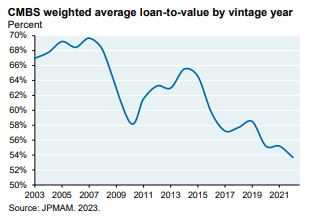The Challenges in Commercial Real Estate
Telemus Weekly Market Review April 10th - April 14th, 2023
In February there were multiple large, well regarded, institutional real estate investors that handed the keys to properties they owned over to their lenders. This raised eyebrows on their willingness to do this and refocused attention on the challenges being faced in the commercial real estate (CRE) market. Over the past year, interest rates have shot higher, the pace of rent growth has slowed, vacancies have risen in many sectors, valuations have compressed, and borrowing conditions have tightened. Over the past couple of months, markets have begun to focus on these risks and concerns more intently.
A key trepidation rests on the perceived looming wall of debt maturities on commercial properties. There is $1.1 trillion of commercial real estate debt that collectively matures in 2023 and 2024. The amount of maturities in these years is slightly higher than previous years as well as 2025 and beyond. This headline gets a lot of attention, but with many things when you peel back the onion there is more to it. First, $1.1 trillion in maturities over the next two years represents just over 5% of the total value of U.S. commercial real estate, based on a 2021 analysis conducted by NARIETi. Since the Great Financial Crisis (CFC) we’ve seen an improvement is loan quality as the average loan-to value went from roughly 70% twenty years ago to 55% today. In addition, the average debt service coverage ratio sits at 2.6x, or put differently the amount of net operating income exceeded the interest expense at the time of underwriting by 260%. This is up from roughly 1.6x twenty years ago. Therefore, the quality of underlying credit metrics would indicate commercial real estate loans had less risk going into the recent rate hiking campaign than they did heading into the GFC. However, after the Federal Reserve has increased the federal funds rate by 4.75% over the past year, there is no question credit metrics have changed.

A lot of attention has been paid to the exposure banks have to commercial real estate debt. Banks account for over 50% of all outstanding commercial real estate borrowings. Given the liquidity pressures that banks have been facing due to the failures of Silicon Valley Bank and Signature Bank, the added risk of potential problems in loan portfolios adds to bank investor anxiety. What gets overlooked in this analysis is that banks don’t have much of a debt maturity wall. In fact, the higher amount of loans maturing in the next two years come from elevated maturities of commercial mortgage backed securities (CMBS). CMBS securities are bonds that are backed by underlying commercial real estate.
Commercial Real Estate Debt Maturities (by year)

Present conditions would indicate that banks have yet to see the stress from commercial real estate. According to Federal Reserve data, delinquencies on commercial real estate loans were just 0.68% in the fourth quarter of 2022. The combination of strong current conditions, and the lack of a large wall of maturities, would indicate that any stress banks feel from commercial real estate loans is likely to be gradual and not an overnight stress like what was experienced during the GFC.
Just because we have yet to see stress in commercial real estate loans doesn’t mean we don’t expect them. We know that valuations are under pressure, the strong rent growth of 2021 is starting to roll over, and occupancy levels are no longer improving. On the financing side, undoubtedly interest costs are going to be higher when it comes time to refinance a loan as it matures. In addition, according to the Federal Reserve, 57% of banks have indicated they are tightening lending criteria on commercial real estate loans. This would translate into a reduction in the amount of debt banks are willing to lend on relative to the property’s value.
To frame the challenges borrowers are likely to face when refinancing, let’s look at a sample scenario. Take a $10 million property that was financed with $5 million of debt (a 50% loan-to-value) five years go. Today, it may be worth $9 million, and due to tighter lending criteria, a bank may only be willing to refinance the property at a 40% loan to value, or $3.6 million worth of debt. This would require the property owner to put up $1.4 million of capital when refinancing the maturing loan. Adding to the pain, with borrowing costs much higher, the property owner will likely be paying a higher amount of interest expense, even on a smaller amount of debt outstanding. Healthy borrowers may not like this but will be able to handle it. Borrowers that are capital or cash flow constrained, or experience a more meaningful drop in property value, may face a more distressed situation.
While we see persistent pressure on the asset class for a multi-year period, we think that pressure will be uneven. Multi-family or apartment properties may be pressured in the near-term as vacancies rise and rent growth softens. An influx of new apartment complexes hitting the market during 2023 could further pressure rents. However, fundamentally long-term housing supply remains at a deficit, and we could see an acceleration in rent growth returning in late 2024 or 2025. Multi-family properties also have more diverse funding sources with government agencies (Fannie Mae, Freddie Mac, HUD) providing readily available pools of financing at reasonable rates. This should support the sector more than others, like office, where available financing is constrained.
Current economic and market conditions will undoubtedly lead to some stress for commercial real estate. It’s likely that this stress may linger for a period of years as not all properties are going to be impacted at the same time. Moreover, not all properties are going to be impacted equally. The valuation paid for the property, the amount of debt used to finance it, the terms of the loan, and the strength of the underlying tenant base will all play a role.
We continue to view real estate as an attractive asset class over the long-term. Rising rates during 2022 started the process of adjusting valuations lower. We wouldn’t be surprised to see more downward pressure on valuations during 2023. However, strategies that are deploying capital can purchase properties at these more attractive valuations. There may also be chances to add value through opportunistic property purchases. Ultimately, we expect some episodes of pressure alongside periods of opportunity for real estate investors over the coming real estate cycle. The current rhetoric and concern around commercial real estate certainly has some merit to it, however, the intensity of these concerns may be overblown given the reasons we’ve discussed.
ihttps://www.reit.com/data-research/research/nareit-research/estimating-size-commercial-real-estate-market-us-2021#:~:text=The%20estimated%20total%20dollar%20value,trillion%20as%20of%202021%3AQ2.&text=This%20research%20note%20summarizes%20a,trillion%20as%20of%202021%3AQ2.
All opinions expressed in this article are for general informational purposes and constitute the judgment of the author(s) as of the date of the report. These opinions are subject to change without notice and are not intended to provide specific advice or recommendations for any individual or on any specific security. The material has been gathered from sources believed to be reliable, however Telemus Capital cannot guarantee the accuracy or completeness of such information, and certain information presented here may have been condensed or summarized from its original source. PAST PERFORMANCE IS NOT A GUARANTEE OF FUTURE RESULTS. Investment decisions should always be made based on the client's specific financial needs, goals and objectives, time horizon and risk tolerance. Current and future portfolio holdings are subject to risk. Risks may include interest-rate risk, market risk, inflation risk, deflation risk, currency risk, reinvestment risk, business risk, liquidity risk, financial risk, and cybersecurity risk. These risks are more fully described in Telemus Capital's Firm Brochure (Part 2A of Form ADV), which is available upon request. Telemus Capital does not guarantee the results of any investments. Investment, insurance and annuity products are not FDIC insured, are not bank guaranteed, and may lose value. Any reference to an index is included for illustrative purposes only, as an index is not a security in which an investment can be made. Indices are unmanaged vehicles that serve as market indicators and do not account for the deduction of management fees and/or transaction costs generally associated with investable products.
Advisory services are only offered to clients or prospective clients where Telemus and its representatives are properly licensed or exempt from licensure. No advice may be rendered by Telemus unless a client service agreement is in place. All composite data and corresponding calculations are available upon request.

Matt joined the Telemus team in 2018. As Chief Investment Officer, he leads the firms the investment process and research effort. Matt has experience as an equity analyst and portfolio manager and has advised corporate pension plans on their manager selection. He’s been quoted in Money Magazine and Barron’s.









